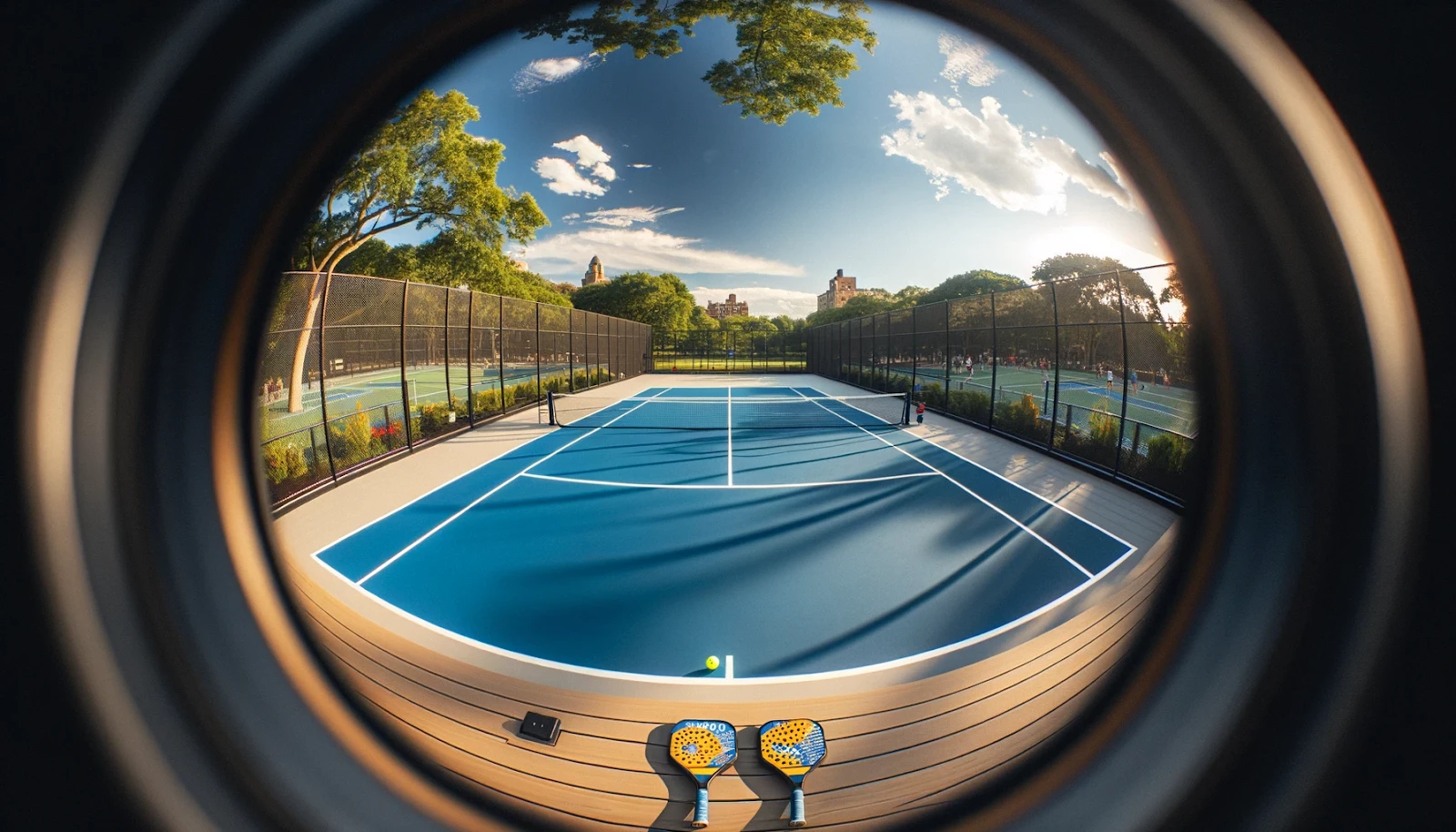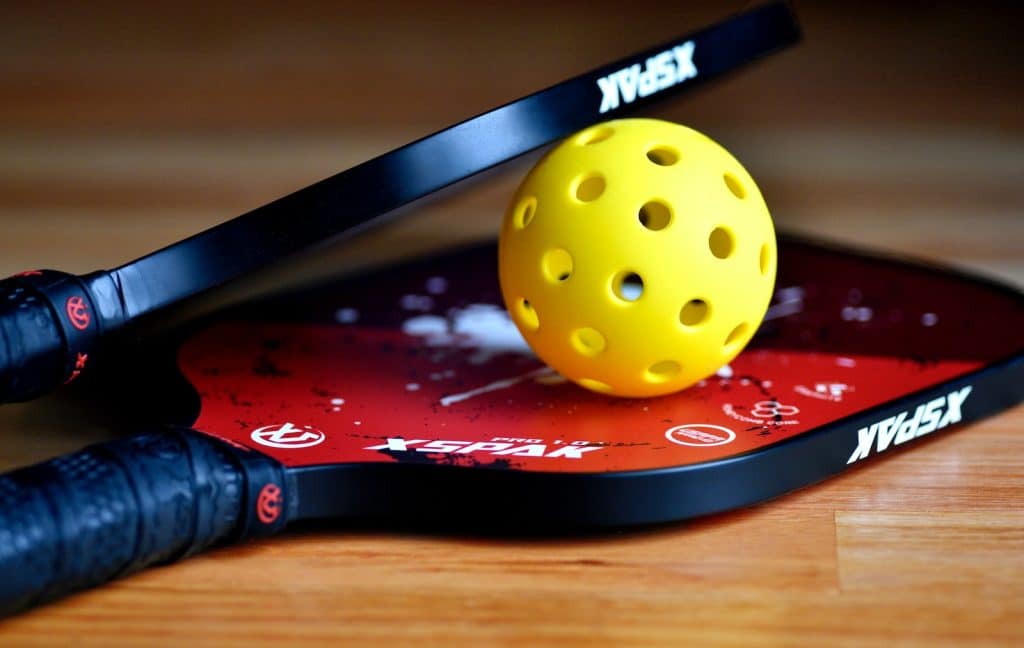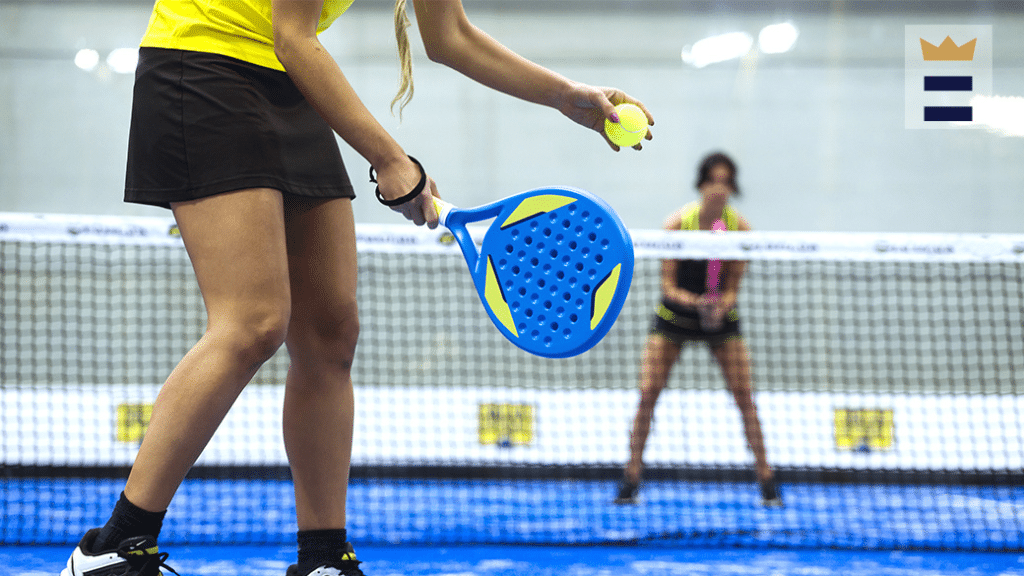The dimensions of a regulation pickleball court are 20 ft x 44 ft for both singles and doubles play. This is roughly half the size of a tennis court.
As pickleball continues to gain popularity, more and more people are looking to set up their own pickleball courts. Understanding the proper dimensions and layout of a regulation pickleball court is key!
In this article, we will cover everything you need to know about pickleball court specifications – from the size and zones of the court to the lines, surfaces, and net setup. We’ll also compare dimensions of a pickleball court to tennis courts, provide tips on setting up a pickleball court measurements yourself, discuss playing pickleball on different surfaces, and examine the costs and benefits of installing a court. Let’s dive in!
Table of Contents
Pickleball Court Dimensions
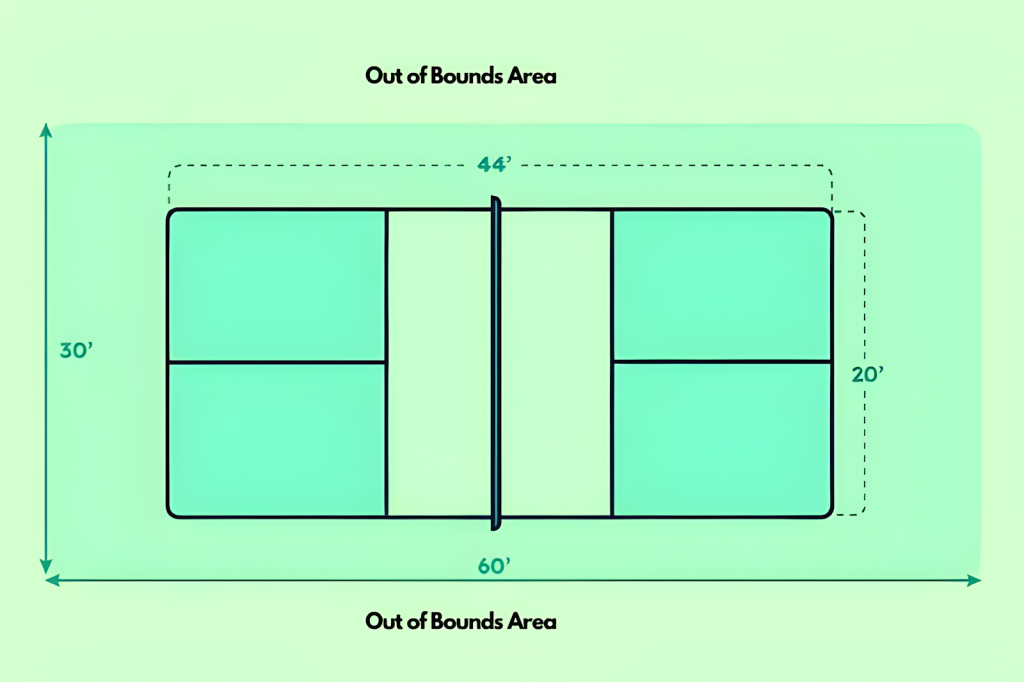
Let’s start by examining the official pickleball court size and the dimensions of a regulation pickleball court as outlined in the USA Pickleball Association (USAPA) rulebook. This encompasses specifics such as the court’s length, width, total area, playing zones, and net height.”
Court Length and Width
Pickleball court size in feet:
- Length: 44 feet (13.41 meters)
- Width: 20 feet (6.1 meters)
So a standard pickleball court should measure 44 feet long by 20 feet wide for a total play zone of 880 square feet (81.8 square meters).
Height of a Pickleball Net

Inside the length and width court boundaries sits the pickleball net. Standard pickleball net height specifications are:
- 36 inches (91.4 cm) tall at the sidelines
- 34 inches (86.4 cm) tall at center court
So the net starts 36 inches high at either sideline post, and then droops by 2 inches towards a 34 inch height at the center line for the appropriate amount of sag.
Service Courts
Behind the pickleball net on either side lie the service courts. According to USA Pickleball Association guidelines, regulation service courts for doubles and singles matches should follow these dimension rules:
- 15 feet (4.57 m) wide
- 20 feet (6.1 m) long
The two service courts oppose each other diagonally on either side of the net. All serves must be made from the right-hand service court diagonally to the opponent’s right hand service court.
Non-Volley Zone
Lastly, included within the service court area on both sides of the net is the “non-volley zone”, also referred to as the NVZ or the “kitchen”. This no-volley region has the following official dimensions:
- 15 feet (4.57 m) wide
- 7 feet (2.1 m) deep
So the non-volley zone comprises a 15 foot wide section that starts at the net and extends back 7 feet towards the baseline within the standard service court space.
No volleying is permitted within this kitchen area. Players can only enter the non-volley zone to return balls that bounce. All violators are penalized under formal pickleball rules.
Half-Court Layouts
For smaller play zones, half-court pickleball setups are also sanctioned using these measurements:
- Length: 20 feet 2 inches (6.15 m)
- Width: 10 feet (3.05 m)
- Service court: 10 feet (3.05 m) by 12 feet (3.66 m)
- Non-volley zone: 5 feet (1.52 m) by 7 feet (2.13 m)
So everything is basically the same size but sliced in half, while maintaining all other standard court specifications like net height. Half-court pickleball plays faster with more quick volleys.
Pickleball Court Lines and Surfaces
Much like a tennis court, a pickleball court contains a variety of lines to mark the boundaries and zones of play:
- Baselines: The back boundary lines on both sides of the court
- Sidelines: The side boundary lines running the length of the court
- Non-Volley Zone Lines: The lines marking the non-volley zone boundaries
- Centerline: The line bisecting the two sides of the court under the net
- Service Courts: The service court boundaries diagonal to each other across the net
The recommended surface for a pickleball court is smooth asphalt or concrete. Compared to porous or textured surfaces, these hard surfaces provide better ball bounce predictability and more accurate ball rolls. That being said, pickleball can be played on any flat surface, including sport court tiles, wooden gym floors, concrete driveways etc. Just keep in mind that ball behavior may vary.
Proper line marking is essential on any pickleball court surface. Lines should be between 2–4 inches (5–10 cm) wide. Most popular line marking solutions include: white paint, chalk powder, gaffer’s tape, and peel-and-stick vinyl tape. Just be sure that pickleball lines are clearly visible and distinguishable from the rest of the playing surface.
How Pickleball Courts Compare to Tennis Courts
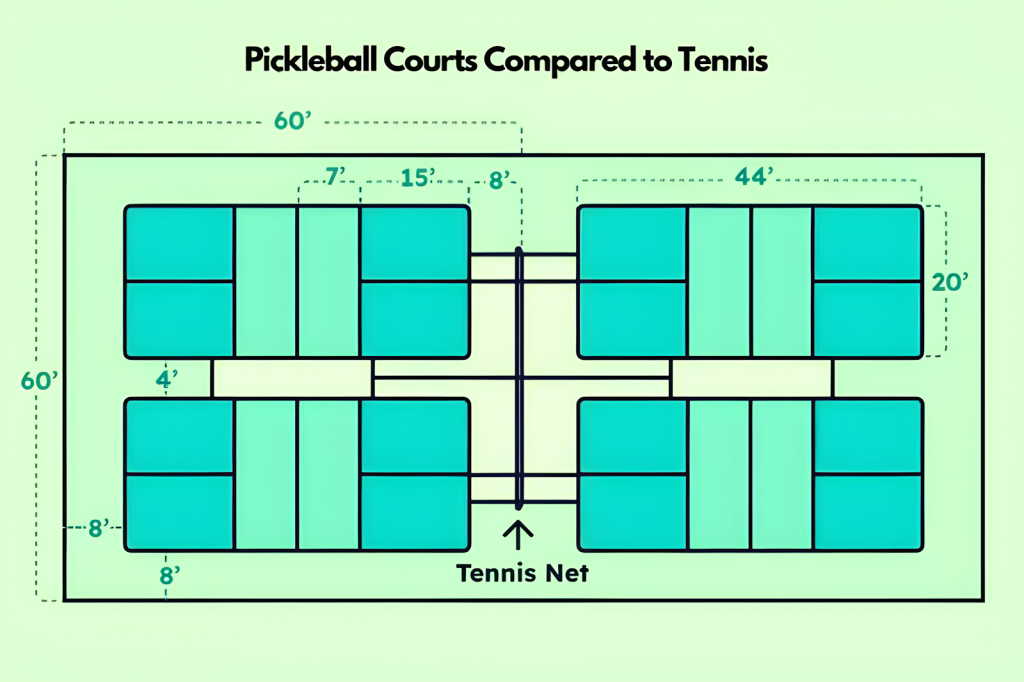
Temporary pickleball courts are often established on various existing sports surfaces, including those for basketball courts, volleyball courts, badminton courts, and inline hockey. However, the most frequently adapted surface for shared pickleball use is a tennis court. This saves costs while capitalizing on the existing courts and infrastructure. But how exactly do the dimensions and specifications compare?
Court Size Comparison
Tennis courts measure:
- Length – 78 feet (23.77 m)
- Width – 27 feet (8.23 m)
- Total area – 2,106 sq ft (195.29 sq m)
Whereas regulation pickleball courts are:
- Length – 44 feet (13.41 m)
- Width – 20 feet (6.10 m)
- Total area – 880 sq ft (81.76 sq m)
So a dedicated pickleball court occupies less than half the total surface space of a tennis court. The shorter length and width enable more smashing drives, plus closer plays up at the non-volley zone.
Net Height Differences
Tennis court net heights are:
- 3 feet (0.91 m) at net posts
- 3.5 feet (1.07 m) at center with sag
Pickleball court net heights are lower:
- 3 feet (0.91 m) at sides
- 3 feet 2 inches (0.96 m) at center
This lower net clearance aids pickleball volleys and overhead slams compared to tennis.
Layout Differences
Besides the size variance, some other notable court layout distinctions exist:
- Tennis courts lack a non-volley zone
- Tennis service boxes are diagonal corner-to-corner vs. right-to-right
- Tennis also includes an extra “alley” area along the sidelines
So while repurposing tennis real estate as pickleball courts is convenient, do account for these measurement discrepancies when reconfiguring boundaries, lines and net placement.
Setting Up a Pickleball Court
Want to set up your pickleball court? Here is an 8-step guide:
- Step 1: Choose a Flat Surface
Select a level area of at least 30 feet (9.1 m) wide and 60 feet (18.3 m) long. Driveways or blacktop playground areas work perfectly. Grass courts are not recommended.
- Step 2: Measure and Mark Boundary Lines
Use chalk lines, tape measures, survey flags etc. to accurately map out 20 foot (6.1 m) width and 44 foot (13.4 m) length dimensions. Mark the court boundary lines and sidelines.
- Step 3: Add Centerline and Non-Volley Zone Lines
Split length into two 22 foot (6.7 m) halves. Mark a centerline bisecting the court lengthwise. Measure and mark 7 foot (2.1 m) non-volley zones parallel to the centerline.
- Step 4: Draw Diagonal Service Court Lines
Connect the non-volley zone corners closest to the net across to the opposite baseline corners.
- Step 5: Set Up Net in Center
Install net posts 3 feet (0.9 m) outside sidelines. Attach net at 36 inch (91 cm) height at sidelines using tennis court net hardware. Hang center net max 34 inches (86 cm) high.
- Step 6: Check Measurements and Lines
Verify all court dimensions, boundaries, lines are accurate per official pickleball standards before finalizing.
- Step 7: Add Visual Contrast Lines
For visibility, use chalk, tape, paint etc. to make lines clearly distinguishable from the court surface.
- Step 8: Surround Court Perimeter
Install fencing, barriers or safety surfacing at least 6 feet (1.8 m) behind baselines and sidelines perimeter to prevent balls escaping too far.
Voilà! Your DIY pickleball court is prepared, and it’s time to play pickleball. Be sure to check measurements routinely to maintain regulation court dimensions. Having even a few inches variation can negatively impact gameplay.
Playing Pickleball on Different Surfaces
While a flat, smooth concrete or paved surface is ideal, pickleball can be enjoyed on different surfaces:
Tennis Courts
Tennis courts make great pickleball courts with the help of portable nets and pickleball boundary marking tape. Be mindful of the different court dimension requirements.
Driveways
Driveways are perfect for casual pickleball with the correct length and width dimensions. Use chalk or tape to mark lines. Caution for vehicle obstacles.
Indoor Gym Floors
Vinyl sport court tiles, wooden gym floors or concrete can all work inside. Gym ceiling height should be at least 20 feet (6.1 m).
Grass
Grass works for casual play only. Lack of smooth/consistent surface and ball roll impede proper play. Great for beginners, though.
Playground Blacktop
Blacktop is chalk line-ready for pickleball. Ensure adequate length/width when designating court boundaries.
No matter the surface, accurate line marking for boundaries, non-volley zones and service courts is a must per official pickleball rules and dimensions.
Cost and Worth of Pickleball Courts
Installing a dedicated pickleball court involves significant expense. Exact pricing depends on factors like:
- Location
- Court surfacing
- Fencing
- Accessories e.g. nets, padding, lights etc.
That said, owning your own pickleball court has many advantages:
- Play anytime without court booking issues
- Host visitors/tournaments
- Enjoy suitable court conditions
- Tailor surfacing, gear to your preferences
- No rental or membership costs
- Excellent home value addition
The accessibility and flexibility of a home court can provide years of ongoing enjoyment for avid players.
Conclusion
In summary, a standard pickleball court is a blend of tennis, badminton, and table tennis, measuring 44 feet in length and 20 feet in width, totaling 880 square feet. It features a net height of 36 inches at the sidelines and 34 inches at the center, with service courts of 15 by 20 feet, and a non-volley zone 15 feet wide and 7 feet deep.
Half-court options are available for smaller spaces. Courts typically have a smooth surface like asphalt or concrete for better ball play. Compared to tennis courts, pickleball courts are smaller and encourage a more dynamic game. The court can be set up on various surfaces like tennis courts, driveways, and indoor floors.
The installation cost varies, but the benefits make it appealing for enthusiasts. Proper court setup is essential for a genuine and enjoyable pickleball experience.
